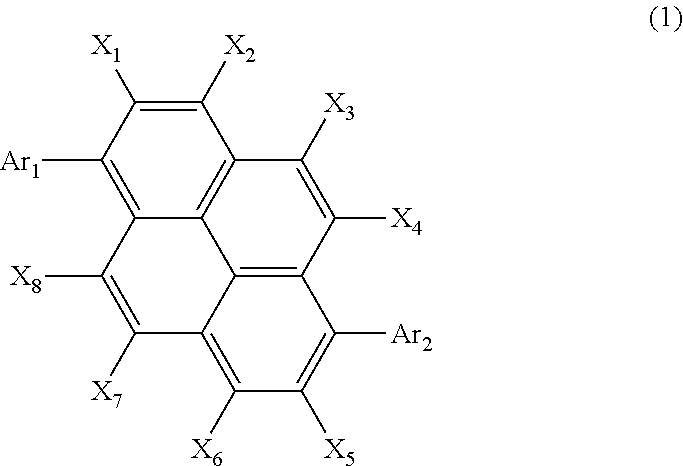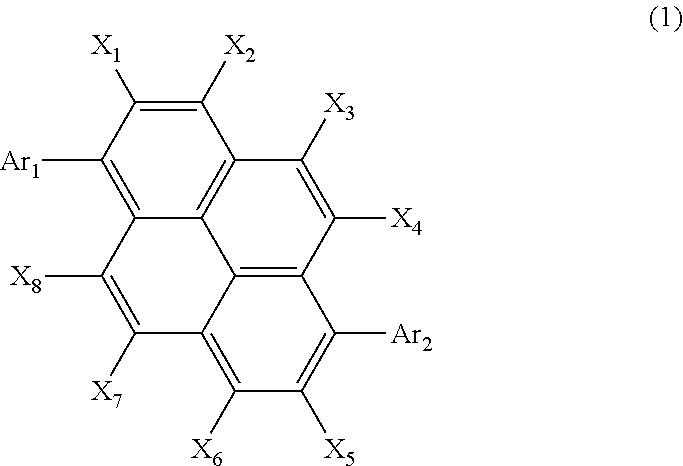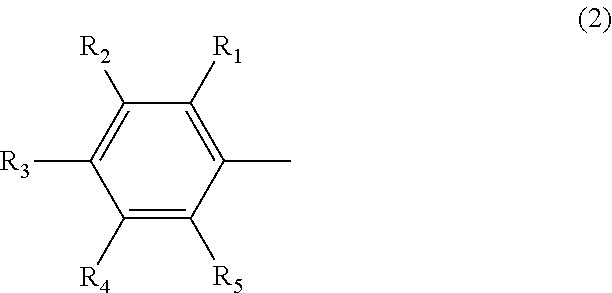Organic electroluminescent element using pyrene derivative
a technology of electroluminescent elements and derivatives, which is applied in the direction of discharge tubes/lamp details, discharge tubes luminescnet screens, organic chemistry, etc., can solve the problems of low luminance and luminous efficiency, high driving voltage of devices, and inability to realize practical application of devices, etc., to achieve high blue color purity and long life
- Summary
- Abstract
- Description
- Claims
- Application Information
AI Technical Summary
Benefits of technology
Problems solved by technology
Method used
Image
Examples
production example 1
[0106]Compound 1 was synthesized according to the following scheme.
Synthesis of 1,6-diphenylpyrene
[0107]Under an argon atmosphere, 15.0 g of 1,6-dibromopyrene, 13.2 g of phenylboronic acid, 1.9 g of tetrakis(triphenylphosphine)palladium (0) [Pd(PPh3)4], 27.8 g of sodium carbonate (130 mL of clean water), toluene and tetrahydrofuran were placed into a flask, and the resulting mixture was allowed to react at 90° C. for 7 hours. After cooling, the reaction solution was filtered, and solids obtained were washed with methanol and clean water. Further, the solids were purified by silica gel chromatography (heated toluene). The resulting crude product which was obtained by a concentration was re-crystallized from toluene, followed by drying under a reduced pressure, whereby white solids of 1,6-diphenylpyrene (11.8 g) were obtained.
Synthesis of 3-bromo-1,6-diphenylpyrene
[0108]Under a flow of argon, 11.8 g of 1,6-diphenylpyrene, 5.93 g of N-bromosuccinimide and DMF were placed into a flask. ...
production example 2
[0111]Compound 2 was synthesized according to the following scheme.
[0112]Compound 2 was synthesized by conducting a reaction in the same manner as in Production Example 1, except that 1-naphthylboronic acid was used instead of 2-naphthylboronic acid.
[0113]Compound 2 was identified by mass spectroscopy, and m / e was 480 for molecular weight of 480.19.
production example 3
[0114]Compound 3 was synthesized according to the following scheme.
[0115]Compound 3 was synthesized by conducting a reaction in the same manner as in Production Example 1, except that 9-phenanthrenylboronic acid was used instead of 1-naphthylboronic acid.
[0116]Compound 3 was identified by mass spectroscopy, and m / e was 530 for molecular weight of 530.20.
PUM
| Property | Measurement | Unit |
|---|---|---|
| Fraction | aaaaa | aaaaa |
| Fraction | aaaaa | aaaaa |
| Fraction | aaaaa | aaaaa |
Abstract
Description
Claims
Application Information
 Login to View More
Login to View More - R&D
- Intellectual Property
- Life Sciences
- Materials
- Tech Scout
- Unparalleled Data Quality
- Higher Quality Content
- 60% Fewer Hallucinations
Browse by: Latest US Patents, China's latest patents, Technical Efficacy Thesaurus, Application Domain, Technology Topic, Popular Technical Reports.
© 2025 PatSnap. All rights reserved.Legal|Privacy policy|Modern Slavery Act Transparency Statement|Sitemap|About US| Contact US: help@patsnap.com



